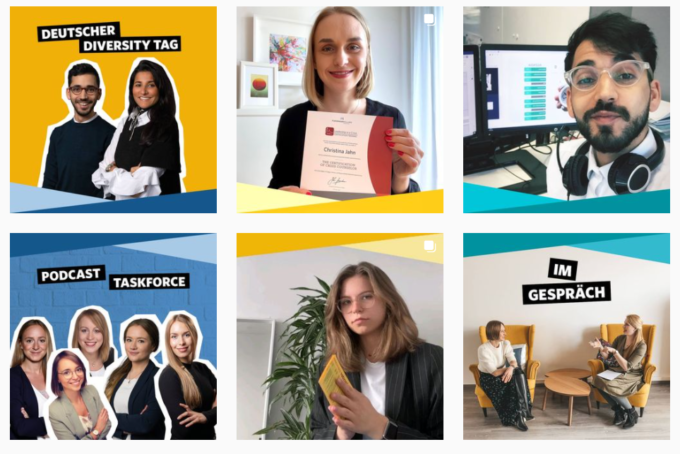Fünf Tipps für digitales Employer Branding – gerüstet für die Schlacht um Personal im Netz
 The war for talent is already a reality for many companies: The battle for the best talents, which has been on the horizon for a long time, is now decisive for the profit and loyalty of employees. This makes it all the more important not only to have a strong corporate brand, but also active employer branding: positioning as an attractive employer brand – offline and online.
The war for talent is already a reality for many companies: The battle for the best talents, which has been on the horizon for a long time, is now decisive for the profit and loyalty of employees. This makes it all the more important not only to have a strong corporate brand, but also active employer branding: positioning as an attractive employer brand – offline and online.
Connect with Stefanie Soehnchen on LinkedIn
Considerations on the topic of “How do we want to present ourselves as an employer in our communications?” are now part of every communications strategy, because employees and applicants are always stakeholders and the target group for corporate messages.
A “Who are we?” stands in contrast to a “Who do we want to attract? Who do we want on the team?”
Just as with all other (digital) audiences, the first step to successful, relevant communication is for communicators to consider how the brand message fits with the expectations of the target audience.
“What should we tell so that it fits us and our target group?” is the question. The next step is to communicate this attractively, both visually and in terms of content, wherever the target group is.
Accordingly, the best LinkedIn channel is of no use if my target group only uses Instagram.
We will show how these and other strategic considerations can look in practice using the Instagram account of Fleishman Hillard Germany, which has “employer branding” as its main communication goal.
1. People love people
The top priority in employer branding: show it like it really is. Stock photos are to be absolutely avoided – whether on websites, social media channels or even on trade fair booths. Stock photos are deliberately interchangeable and generic in their look and feel and thus offer few points of contact and identification. Viewers should get a sense of who works for us, what that might look like, and whether they fit in.

Depending on the touchpoint, the photos may be more or less professional – for Instagram, you don’t need a shoot every time, but for the website it would be advisable. But with real employees in a real office environment.
For evolutionary reasons, we look other people in the eye first in order to recognize conspecifics. Friendly people who look at me can trigger a feeling of welcome and belonging.
We have a cross-departmental team involved in content creation that invites colleagues from all areas to contribute to specific topics. This allows us to showcase our expertise, but also the diversity of our team.
2. Media mix
As with pull communication in general, the media mix also depends on the expectations and habits of the target group.
If you stubbornly push out pictures, but the target group prefers to consume stories, you will not get the desired result.
Employer branding in particular is all about behind-the-scenes material – photos and videos should show what the working world looks like, the office world, being with colleagues.
That’s why a good mix should be ensured as early as the editorial planning stage. For us, for example, this means 3-5 feed posts per week, at least one story with interactive elements per week, and a mix of single image and carousel posts.
Employees show themselves both at work and at work for customers – for example, as workshop moderators or behind the camera on field shoots.
3. Corporate design: that extra bit of professionalism
To give content a visual sender as well, it’s a good idea to create a version of the corporate design (CD) for social media.
This can either be very uniform, à la “pictures always look like this”, or can represent a range from “strongly branded” to “little branded” – depending on what is appropriate per post. For example, job ads could be heavily branded at most, while information about parental leave might be more subtle.

In fact, a good CD creates an extra level of communication professionalism and a high recognition value in the stream as well as when sharing the content.
The employer brand is closely linked to the corporate brand. Therefore, if you can also show what the professional look and feel looks like in action in the social media posts around employer branding, you can create a higher identification with the brand.
We chose a rather elaborate grid system with recurring color patterns from our color world, which rewards users with a special look when they visit our profile.
4. Community building
For many companies, the social media effort stops at community management. That is, they process the comments and messages that come in on their own channel.
But what they don’t consider are the many, many users who are not yet fans of their own channel and who may not even have had any contact with the brand. And that’s where community building comes in.
Of course, this does not only apply to employer branding, but it is particularly important here: In community building, social media managers deliberately select other channels, users and hashtags that fit their (employer) brand and become active there. This can be done by simply following, but even better by actively liking and commenting in order to get on the radar of the channel operators and their community.
This is how relevant organic growth can happen.
We have clear KPIs for this in our team. We answer every comment, but we also find at least five relevant new channels to follow per week and write several comments under relevant posts per day. This community management and building is done by a different team of two from our editorial team every week, so everyone only has to do it every few weeks.
5. Smell what sells – or: test, test, test.
If you don’t have a clear strategy right from the start – also for (digital) employer branding – you can’t hope for the same success that competitors with a clear strategy will have.
That’s why it needs a good foundation with which to manage channels and content. In fact, some of this is trial and error – for example, what is the best length of text to please the target audience. Or what kind of visuals are best received. Or which content elements are well suited for series.
That’s why it’s always a good idea to test specifically what performs best against the KPIs. The rule here is: just not too many things at the same time, because otherwise it’s difficult to evaluate what the decisive factor was.
For example, we test said text length, amount of hashtags, posting times and days, or story lengths and interactions in stories.
If you take these factors into account when positioning your digital employer brand, you will have taken the first important steps toward professionalizing your employer brand.
For business-relevant communication content like this, why not sign up for our newsletter “FleishmanHillard Quarterly”, follow FleishmanHillard Germany on LinkedIn or Twitter, get to know our team on Instagram or visit our YouTube channel.
Find Out More
-
Why we tell the truth
May 23, 2022


